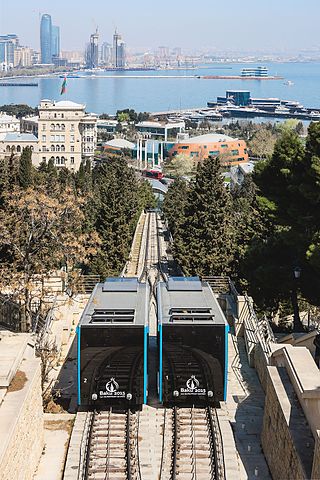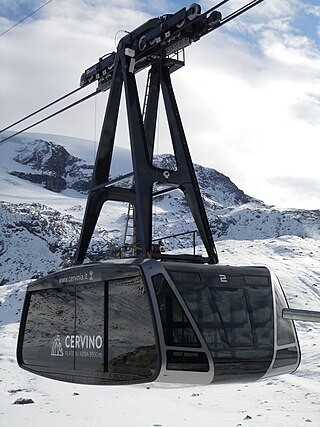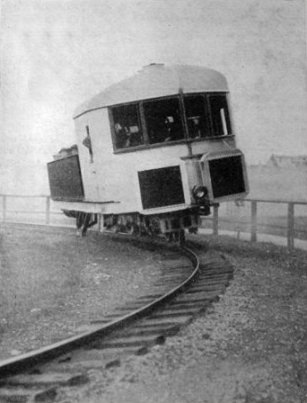Types
- Monorackbahn alignment in a vinayard near Mundelsheim
- Diesel powered car of Monorackbahn in a vineyard near Kobern-Gondorf
- Electrical people mover based on a Monorackbahn
Monorackbahn is a small monorail rack railway manufactured by the Doppelmayr/Garaventa Group. Its style is derived from industrial monorails used in 1960s vineyards. There are more than 650 Monorackbahn systems installed across Switzerland, Germany and Italy.
The idea for the development of the Monorackbahn started in the 1960's and came from Japan in the form of slope cars which were used on orchards. The original manufacturer Yoneyama Industry named them "Monorack" (モノラック, Monorakku) by 1966. The first models were primarily used for transporting bags of fruit in the beginning. Garaventa designed similar systems for usage in vineyards in the 1960s which could also carry workers. It did pick up the brand name Monorack by 1976. The main difference between the Japanese and European systems was the type of rail being used for tracks with the Japanese systems using 4 cm and the European systems using 6 cm square tubing. [1] The cooperation between Nikkari in Japan and Habegger in Switzerland started in 1975, so the Monorack tractors are mostly identical. [2] [1] [3]
The Garaventa system is designed for loads up to 250 kilograms (550 lb) and 100% (45°) slopes. In the newest system (as of 2021) an 48 Volt Li ion battery pack is used with a 6 kW motor. The base size of 3.6 kWh allows for 60 min of operation. Connector pads for the charging stations can be attached to the rail so that recharging starts automatically at the end points. [4] The system is so prevalent in vineyards along the Rhine that it is also named Vinayard rail (German Weinbergsbahn). This is ambiguous as Feldbahn system are also used for agricultural transportation including vineyards. Apart from usage in vineyards, Monorackbahn systems are also found at complex construction sites in Europe.

A monorail is a railway in which the track consists of a single rail or a beam.

A funicular is a type of cable railway system that connects points along a railway track laid on a steep slope. The system is characterized by two counterbalanced carriages permanently attached to opposite ends of a haulage cable, which is looped over a pulley at the upper end of the track. The result of such a configuration is that the two carriages move synchronously: as one ascends, the other descends at an equal speed. This feature distinguishes funiculars from inclined elevators, which have a single car that is hauled uphill.

A people mover or automated people mover (APM) is a type of small scale automated guideway transit system. The term is generally used only to describe systems serving relatively small areas such as airports, downtown districts or theme parks.

An aerial tramway, aerial tram, sky tram, aerial cablecar, aerial cableway, telepherique, or seilbahn is a type of aerial lift which uses one or two stationary ropes for support while a third moving rope provides propulsion. With this form of lift, the grip of an aerial tramway cabin is fixed onto the propulsion rope and cannot be decoupled from it during operations. In comparison to gondola lifts, aerial tramways generally provide lower line capacities and higher wait times.

A rack railway is a steep grade railway with a toothed rack rail, usually between the running rails. The trains are fitted with one or more cog wheels or pinions that mesh with this rack rail. This allows the trains to operate on steep grades above 10%, which is the maximum for friction-based rail. Most rack railways are mountain railways, although a few are transit railways or tramways built to overcome a steep gradient in an urban environment.

DB Cargo is an international transport and logistics company. It is responsible for all of the rail freight transport activities of the German railway company Deutsche Bahn both inside Germany and on a global level. DB Cargo has a registered office in Mainz and a further administrative office in Frankfurt am Main.

A detachable chairlift or high-speed chairlift is a type of passenger aerial lift, which, like a fixed-grip chairlift, consists of numerous chairs attached to a constantly moving wire rope that is strung between two terminals over intermediate towers. They are now commonplace at all but the smallest of ski resorts. Some are installed at tourist attractions as well as for urban transportation.

Doppelmayr/Garaventa Group is an international manufacturer of ropeways and people movers for ski areas, urban transport, amusement parks, and material handling systems. As of 2019, the group have produced over 15,000 installations in 96 countries. The Doppelmayr/Garaventa Group was formed in 2002 when Doppelmayr of Wolfurt, Austria merged with Garaventa AG of Switzerland to form the world's largest ropeway manufacturer.

An aerial lift, also known as a cable car or ropeway, is a means of cable transport in which cabins, cars, gondolas, or open chairs are hauled above the ground by means of one or more cables. Aerial lift systems are frequently employed in a mountainous territory where roads are relatively difficult to build and use, and have seen extensive use in mining. Aerial lift systems are relatively easy to move and have been used to cross rivers and ravines. In more recent times, the cost-effectiveness and flexibility of aerial lifts have seen an increase of gondola lift being integrated into urban public transport systems.

Doppelmayr USA, Inc is an aerial lift manufacturer based in Salt Lake City, Utah, and a subsidiary of the worldwide Doppelmayr Garaventa Group. The United States company was formed in 2002 after the merger of Garaventa of Goldau, Switzerland, and Doppelmayr of Wolfurt, Austria. Between 2002 and 2010, the company was named Doppelmayr CTEC. From 2011 the company has operated using the Doppelmayr brand name, in common with most other Doppelmayr Garaventa Group subsidiaries.

The gyro monorail, gyroscopic monorail, gyro-stabilized monorail, or gyrocar are terms for a single rail land vehicle that uses the gyroscopic action of a spinning wheel to overcome the inherent instability of balancing on top of a single rail.

Stadler Rail is a Swiss manufacturer of railway rolling stock, with an emphasis on regional train multiple units and trams. It is also focused on niche products, such as being one of the last European manufacturers of rack railway rolling stock. Stadler Rail is headquartered in Bussnang, Switzerland.

A slope car is a small automated monorail, or a fusion between monorail, people mover, and rack railway. It is a brand name of Kaho Manufacturing. Since this mode of transportation is relatively unknown, it lacks widely accepted generic name, other than the simple "monorail". The system is different from normal modern monorails in many ways. It is a development from industrial monorails used in 1960s orchards. Slope cars are installed in more than 80 places in Japan and South Korea.
Von Roll Holding AG is a Swiss industrial group that operates worldwide that was founded in 1803. As one of Switzerland's longest-established industrial companies, Von Roll focuses today on products and systems for electrical applications such as power generation, transmission, and storage as well as e-mobility and industrial applications.

The Cable Liner is a range of automated people mover products designed by Doppelmayr Cable Car for use at airports, in city centers, intermodal passenger transport connections, park and ride facilities, campuses, resorts and amusement parks.
Chennai Monorail was a proposal for a number of lines as part of mass transit system for the Indian city of Chennai. Originally the city planned to use monorail on all lines but many were subsequently changed to railways as part of the Chennai Metro.

A roller container is a container type that can be carried by trucks to be pushed to ground level by help of a hook and level arm with the container possibly sliding on steel roller wheels.
Monorack is the name of either of two monorails running on rack railways. Both systems are used for light loads in steep environments.
Der größte Unterschied zwischen der japanischen Monorailbahn und der europäischen Monorackbahn besteht in der Schiene. Die japanischen Modelle fahren auf einer Schiene von 4 cm Kantenlänge, während die Schienen in der Schweiz und später auch in Deutschland eine Kantenlänge von 6 cm haben. Der Traktor ist vom Aufbau her nahezu gleich.
1966: Developed the first mono-rail carrier for steep slopes for agricultural use (Monorack) in Japan / 1975: Technical cooperation with HABEGGER Maschinenfabrik AG. a mono-rail manufacturer and seller in Switzerland / 2010: Developed a battery-powered mono-rail for one passenger